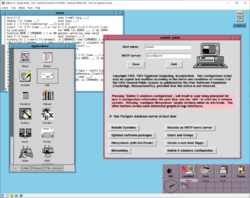Difference between revisions of "Yggdrasil Linux"
m (Add some links) |
m (Not 100 percent sure if what I linked for the alpha release is the mailing list with info about Yggdrasil. Feel freee to fix up as I am not old enough to even know what this is) |
||
| Line 8: | Line 8: | ||
}} | }} | ||
| − | '''Yggdrasil Linux/GNU/X''', also known as '''Yggdrasil''' or '''LGX''', is an early [[Linux]] distribution that could be considered the first live CD Linux [[distribution]]. It describes itself as a “Plug-and-Play” Linux distribution, automatically configuring itself for the hardware. | + | '''Yggdrasil Linux/GNU/X''', also known as '''Yggdrasil''' or '''LGX''', is an early [[Linux]] distribution that could be considered the first live CD Linux [[distribution]]. It describes itself as a “Plug-and-Play” Linux distribution, automatically configuring itself for the hardware. Yggdrasil, named after Norse mythology's world tree, aimed to provide a complete Linux system on a single CD. |
| + | |||
| + | == Releases == | ||
| + | There were 6 releases of Yggdrasil however you can only download 5 of them from [https://pd.spuddy.org/yggdrasil.html here]... | ||
| + | |||
| + | === 1992 Alpha === | ||
| + | The 1992 alpha release was announced on the 25th of November 1992. The first release was on the 8th of December, 1992. The CD-ROM was in the [https://www.kclug.org/old_archives/linux-activists/1992/nov/3/0493.shtml/yggdrasil.html ISO-9660 filesystem] meaning you could view the contents from DOS, other Unix systems and Macintoshes as per the mailing list(?) | ||
| + | |||
| + | This release contained the following software on the CD-ROM: | ||
| + | |||
| + | * Linux 0.98.1 kernel, | ||
| + | * X windows (v11r5) for VGA displays with support for higher resolutions such as 1024x768 256 colors using the ET4000, ET3000, Paradise, or Genoa chip sets, and the standard Xlib/Xt development environment, | ||
| + | * GNU utilities, including GNU C and C++, the GNU debugger, bison, flex, GNU make, | ||
| + | * TeX and groff typesetting packages, | ||
| + | * Ghostscript: a postscript interpreter that can drive a variety of printers and also display in an X window, | ||
| + | * elvis and GNU emacs text editors, | ||
| + | * kermit 5A telecommunications program, and | ||
| + | * an installation script that uses the extended filesystem, which supports long filenames and symbolic links just like the BSD file system, | ||
| + | * iso9660 filesystem with support for the Rock Ridge extensions for reading CDROM's (used by this CDROM distribution), | ||
| + | * lots of other useful programs too numerous to mention. | ||
| + | |||
| + | A 386/486 CPU, 8MB RAM, high-density floppy, 100MB IDE, SCSI or ESDI disk (200MB with sources), SCSI CDROM drive with an Adaptec 1542B, Ultrastor 14F, Future Domain TMC-1660/1680, Seagate ST01/02, or Western Digital 7000fasst SCSI controller were required for this version of Yggdrasil. The alpha distribution consists of the CDROM, and 3.5" and 5.25" high-density bootable filesystem floppies. | ||
| + | |||
| + | === 1993 Beta === | ||
| + | |||
| + | === Fall 1993 === | ||
| + | |||
| + | === Summer 1994 === | ||
| + | |||
| + | === Fall 1994 === | ||
| + | |||
| + | === Fall 1995 === | ||
[[Category: Linux]] | [[Category: Linux]] | ||
Revision as of 03:14, 21 May 2023
| Yggdrasil Linux | |
 Yggdrasil Linux running in the 3.1 version of 86box emulating an ASUS P/I-P55T2P4 | |
| Creator: | Adam J. Richter |
|---|---|
| Architecture: | i386 |
| Date Released: | 1992 |
Yggdrasil Linux/GNU/X, also known as Yggdrasil or LGX, is an early Linux distribution that could be considered the first live CD Linux distribution. It describes itself as a “Plug-and-Play” Linux distribution, automatically configuring itself for the hardware. Yggdrasil, named after Norse mythology's world tree, aimed to provide a complete Linux system on a single CD.
Contents
Releases
There were 6 releases of Yggdrasil however you can only download 5 of them from here...
1992 Alpha
The 1992 alpha release was announced on the 25th of November 1992. The first release was on the 8th of December, 1992. The CD-ROM was in the ISO-9660 filesystem meaning you could view the contents from DOS, other Unix systems and Macintoshes as per the mailing list(?)
This release contained the following software on the CD-ROM:
- Linux 0.98.1 kernel,
- X windows (v11r5) for VGA displays with support for higher resolutions such as 1024x768 256 colors using the ET4000, ET3000, Paradise, or Genoa chip sets, and the standard Xlib/Xt development environment,
- GNU utilities, including GNU C and C++, the GNU debugger, bison, flex, GNU make,
- TeX and groff typesetting packages,
- Ghostscript: a postscript interpreter that can drive a variety of printers and also display in an X window,
- elvis and GNU emacs text editors,
- kermit 5A telecommunications program, and
- an installation script that uses the extended filesystem, which supports long filenames and symbolic links just like the BSD file system,
- iso9660 filesystem with support for the Rock Ridge extensions for reading CDROM's (used by this CDROM distribution),
- lots of other useful programs too numerous to mention.
A 386/486 CPU, 8MB RAM, high-density floppy, 100MB IDE, SCSI or ESDI disk (200MB with sources), SCSI CDROM drive with an Adaptec 1542B, Ultrastor 14F, Future Domain TMC-1660/1680, Seagate ST01/02, or Western Digital 7000fasst SCSI controller were required for this version of Yggdrasil. The alpha distribution consists of the CDROM, and 3.5" and 5.25" high-density bootable filesystem floppies.